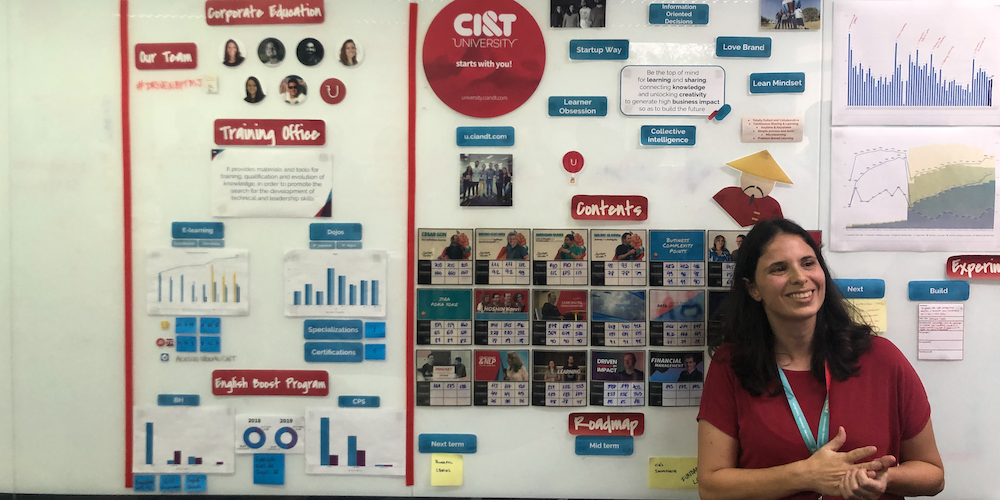
A lean transformation is a cognitive transformation
FEATURE – By looking at two practical examples, the authors discuss the cognitive shift towards learning and continuous improvement that takes place in a lean transformation.
Words: Eivind Reke, Robert Kusén & Daryl Powell
Only a handful of companies achieve lean success over the long term. Yet, as more and more organizations try to embrace Lean Thinking, executives continue to chase the next program of Operational Excellence (Agile transformation, digitalization, cost cutting, modernization, etc), without realizing that the biggest change that is actually required is the cognitive transformation they themselves need to go through.
Lean is a paradigm shift in business thinking and this shift must start at the top. As Leif Östling, the CEO overseeing the lean transformation at Scania, said after seeing the Toyota Production System for the first time: “I knew I didn't understand what I saw, but realized it was something completely different that I needed to understand.”
Back in the early 2000s, Toyota approached Scania to learn more about their unique modular design methodology – something that has now become an important part of Toyota’s own Product Development System with the launch of the Global Architecture that most new Toyota models are based upon. What Scania took away from the meeting with Toyota was the very cognitive transformation we mentioned above.
As a team of authors and practitioners, we have witnessed this transformation of thinking first-hand. However, we have also witnessed lean programs that grind to a halt after achieving a few early successes, with some even regressing past the original starting point. On the surface, it can be hard to distinguish the failed attempts at a lean transformation from the successful ones. Especially early on, before the low hanging fruits – like cleaning up the factory or workshop – start to deteriorate. Nonetheless, we believe there are a few signs that can help us understand what this cognitive transformation looks like.
If you visit Scania today, you might be tricked into thinking that what you see is the result of a successful lean implementation, the type that starts off with the PowerPoint presentation of a roadmap and has all the bells and whistles of lean tools and gets rolled out across the company on pallets to achieve “Operational Excellence”. But that’s not the case. What you are in fact looking at are different teams, units, departments and factories that were all allowed to develop their own thinking and practice, one problem at the time, guided by the fundamental values of respect for people and customers first – and the TPS principles of basic stability, jidoka, just-in-time and kaizen. Step by step, people were allowed to develop a deeper understanding of their own, and each other’s, work, including how they connected with their internal and external customers and how they cooperated with their internal and external suppliers. The biggest transformation at Scania was the cognitive transformation of its executives, managers and operators. Let’s see how it unfolded.
EXAMPLE 1: SCANIA
In the motor assembly plant at Scania, the teams received a visit from their Toyota sensei Glen Umminger. After looking at the changes they had been doing, Umminger realized that, even though improvement meetings where in place and there were signs of 5S and some other improvements, the place looked nothing like what he was used to at Toyota. He challenged the team: “Why are you not working to takt time?” The response was, of course: “Why should we? No-one works to takt in Scandinavia, we are not robots.” (The team was probably also wondering what the crazy Toyota guy expected of them). Glen asked them to try anyway.
They started out by connecting assembly stations, creating better efficiency and at the same time making sure they were not working too fast. The management team in the plant also spent a lot of time discussing how to calculate the allowed buffer size of the in-process stock that separated the different assembly stations. Their conclusion was that it depended on how much of an unforgiving system they were prepared to deal with. Go too low and the impact on their internal customers could be catastrophic. They decided to be conservative, starting with a large bandwidth of 75 (giving a total allowed in-process stock of 150 products or parts).
They didn´t realize it at the time, but the thinking frame of standardized work (takt time, in-process stock, and basic human motion) kept unearthing deviation and after deviation. By slowly reducing the allowed variation, putting pressure on the system, they had accidentally created a deviation-making machine. Kaizen after kaizen, defect by defect, the teams in the motor factory gradually reduced the allowed bandwidth of in-process stock from 75 down to 10. As this happened, they could also reduce in-process stock of finished engines available for final assembly, where they had decided to create an extra-large buffer at the start to be able to deliver to their customers while putting pressure on their own processes. The overall standardized work system forced them to stop early, not allowing for overproduction. At the same time, it was always stable enough to deliver finished products to the final assembly plants, the internal customers. By digging deeper into their own work, the teams in motor assembly were developing deeper knowledge about their production process and building competence in each person.
Over time, stability increased, lead-time was reduced, quality went up, and cost went down, as each new layer of waste was uncovered. The trade-off between just-in-time (sell one, make one) and customer-first (always have an available product for the next process) created the foundations for challenging their own thinking.

EXAMPLE 2: KONGSBERG MARITIME
A similar cognitive transformation took place amongst the employees and leaders on the transducer assembly line at Simrad Spain, a Kongsberg Maritime subsidiary in Alicante. Following an initial Kaizen event, the team was able to reduce the manning on the line from nine operators to three, while simultaneously increasing productivity by up to 50% over a period of 3 to 5 years. Importantly, no one lost their jobs. Instead, the operators freed up from the line were relocated elsewhere in the organization (for example, into customer service or one of the additional product lines recently introduced at the facility).
To achieve this, the operators were taught the principles of just-in-time, jidoka and basic stability, using a lean simulation. Following the initial training, the operators and their leaders started to think differently about their jobs, leading to deeper understanding of the work content. This was subsequently standardized and distributed among the line operators. Furthermore, wasteful activities – such as unnecessary operator motions or looking for missing parts – were removed. The company even engaged the help of internal software engineers to develop a simple Andon system that allowed the operator, in real time, to tell if they were behind or ahead of the takt schedule. After five years, Simrad Spain has achieved 100% growth in productivity with only 50% growth in manpower.

A LEARNING SYSTEM SUPPORTING A COGNITIVE TRANSFORMATION
In contrast to the two case stories presented above, where the emphasis was on developing peoples´ thinking in order to change their actions based on the guiding principles of the Toyota Production System, what we often see are companies that pick a few tools to implement (which they see as matching their particular way of working) – usually 5S, kaizen groups, visual boards, and daily stand-ups – in order to create basic stability. Other times, they will implement a full JIT system as a 16-week program, usually supported by a large consultancy, putting enormous pressure on the people in the organization to work under new and unfamiliar conditions, often with too many problems to deal with at the same time. Executives who hear about lean success stories, like the ones from Scania or Kongsberg Maritime, think that, if they adopt the tools and methods as a set of best practices, they too will quickly experience positive effects on performance. Because their mental model is to implement best practice for quick results, the executives themselves don’t need to change anything in their own thinking. When the effects do not materialize, the conclusion is usually one of the following (or all of them):
- “People in our organization are resistant to change.”
- “Our company is special, so the tools don´t work here.”
- “Lean is only for mass production and we are not a mass producer.”
- “We are not Toyota. Besides, the Toyota/Lean stuff is quite boring these days.”
Such companies typically end up solving a handful of immediate operational problems that at best, allows them to stay in the game. They will never challenge themselves to look for the deeper strategic issues that need to be solved to be able to win that game.
"It is the close observation of little things which is the secret of success in business […] Human knowledge is but an accumulation of small facts, made by successive generations of men, the little bits of knowledge and experience carefully treasured up by them growing at length into a mighty pyramid". (Smiles, 1859)
Back in the early days of his career, Sakichi Toyoda came across Samuel Smiles’ book Self-Help, which had a profound influence on both himself and the company he was creating. The main themes of the book are knowledge, learning, improvement and growth – all core to Toyota’s unorthodox approach to business. They were codified first as the five main principles of Sakichi Toyoda, then as the seven guiding principles of Toyota, and finally in the Toyota Way (2001).
In many ways, the cognitive transformations described here were supported by the companies’ own versions of the Toyota Way – the Scania Way and the Kongsberg Way – as well as the principles of the Toyota Production System. Rather than focusing on the adoption of tools per se, these frameworks were used to define the conditions for learning and continuous improvement in both organizations. This, in turn, provided people in the organizations with the freedom to think differently about the way they carried out their work. In doing so, they learned to solve problems together that were unearthed by TPS and developed a deeper understanding of the work – both theirs and their colleagues’. By challenging their thinking and learning every day to gain deeper knowledge about their own work, everyone – from front-line operator to the CEO – became better at everything they did.
THE AUTHORS



Read more


COLUMN - For her latest column, Sari Torkkola describes the initial steps that must be taken to move towards becoming a lean CIO and warn us against some of the pitfalls along the way.


FEATURE – Last month, the Lean Global Network met in Brazil for its annual meeting. As part of it, we visited several amazing gembas. Three of our lean coaches reflect on what we learned.


FEATURE – A real understanding of Lean Thinking can only stem from an exploration of its tacit aspects, not just its most explicit, easy-to-grasp elements.


FEATURE – In May, the author told us how the IT department at Fuji Xerox Australia used book clubs to engage people in lean. In this update, he explains how the efforts were brought over to a different area of the business.

